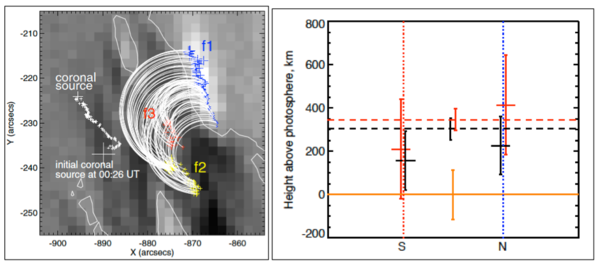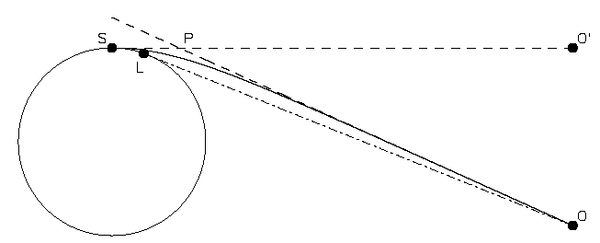RHESSI and General Relativity
From RHESSI Wiki
| Nugget | |
|---|---|
| Number: | 260 |
| 1st Author: | Bill Thompson |
| 2nd Author: | and Hugh Hudson |
| Published: | 7 September 2015 |
| Next Nugget: | Poynting flux |
| Previous Nugget: | Return Current and Resistivity |
| List all | |
Contents |
Introduction
RHESSI provides high-resolution imaging, with metrology stable enough so that formal errors on source centroid locations can be well below one arc sec (e.g., Ref. [1]). The gravitational deflection of the image position of a remote star just grazing the edge of the Sun (the limb) amounts to 1.75 arc sec, as predicted in Einstein's 1916 announcement of the general theory of relativity and famously observed by Eddington during a 1919 total eclipse. Does this imply a need to adjust RHESSI source positions for gravitational effects? Naively one might think "yes", but the answer actually is "no", and it is a bit counter-intuitive.
RHESSI precision
RHESSI records the arrival of each individual X-ray photon, with absolute knowledge of its source angular location via timing and metrology. This absolute knowledge is unusually for a solar imager, where the most frequenty tool for the coalignment of two images is simply to match features. For optical observations, a glimpse of the limb (for example) can provide precise relative information in the solar radial direction, since we know the radius of the Sun to about 40 km. This has been discussed in earlier RHESSI Nuggets about the X-ray limb and about the solar oblateness. The latter is a differential measurement, not an absolute one, and it is important to keep this distinction in mind.
Figure 1 illustrates RHESSI's precision in a couple of ways. The left panel shows a sequence of source positions (the "loop-top source" in particular) that vary quite systematically from point to point. This image (by Säm Krucker) comes from RHESSI's first gamma-ray flare, SOL2002-07-23. Shockingly there seems to be no Nugget on that memorable event, but see this Nugget on coronal gamma-ray sources detected by RHESSI. The right panel of the figure shows an abstracted sketch of the centroid locations of the two footpoints of the white-light flare SOL2011-02-24, now with full error analysis and uncertainty flags. With all sources of uncertainty considered - but not the relativistic corrections - the uncertainties look comparable to the basic knowledge of the solar radius, quite a remarkable achievement for RHESSI's precision and stability.

The right panel of Figure 1 shows an abstracted view of vertical source positions in a flare situated near the limb. These positions have uncertainty ranges approaching one scale height, and certainly smaller than the depth of the chromosphere (some 2,000 km in standard semi-empirical model atmospheres).
Relativity
So, on this scale, where does the relativistic correction fit in? It turns out that for a source on the surface of the Sun, the actual deflection of the radial position is quite small, approximately 1.5 km. As stated in Ref. [2], "...a photon emitted at the solar limb would experience a deflection half that of a star, or about 0.875 arc sec. This should be interpreted not as a shift in plane-of-sky coordinates, but primarily as a shift in the heliographic coordinates." The second sentence conveys the true picture, and no substantial correction to the radial position of a RHESSI (or any other solar) source is required, at current levels of precision. Figure 2 sketches this out, via a huge exaggeration of the (already strong) solar gravity to make the point clear. The large angle in the figure (O'-P-O) is the deflection that the photon experiences. For one solar mass, this is 0.875 arc seconds. The smaller angle (L-O-P) is the effect that the deflection has on the apparent solar diameter, which is about 0.002 arc seconds for the Sun.
The small radial displacement of a photon emitted from the solar surface can also be inferred from a simple and elegant argument based solely on conservation of the photon's energy and angular momentum (Ref. [3]).
Conclusion
The conclusion that relativistic effects do not change the radius of the Sun very much by our (X-ray and white-light) standards is OK, but it does not apply to the much more precise observations of ALMA and radio observatories with ultra-precise measurement capability for remote point-like sources such as pulsars or quasars.
References
[1] "The Height of a White-light Flare and Its Hard X-Ray Sources"
[2] "Precision effects for solar image coordinates within the FITS world coordinate system"
[3] "Relativistic effects on the solar radius"
| RHESSI Nugget Date | 7 September 2015 + |
| RHESSI Nugget First Author | Bill Thompson + |
| RHESSI Nugget Index | 260 + |
| RHESSI Nugget Second Author | and Hugh Hudson + |
